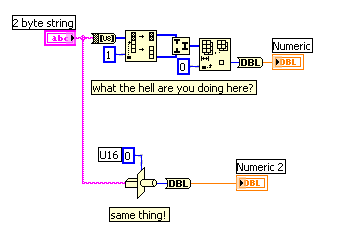- Subscribe to RSS Feed
- Mark Topic as New
- Mark Topic as Read
- Float this Topic for Current User
- Bookmark
- Subscribe
- Mute
- Printer Friendly Page
Why does my application slow down?
02-22-2007 02:23 PM - edited 02-22-2007 02:23 PM
- Mark as New
- Bookmark
- Subscribe
- Mute
- Subscribe to RSS Feed
- Permalink
- Report to a Moderator
Message Edited by roberto.venetz on 02-22-2007 02:23 PM
02-22-2007 02:40 PM
- Mark as New
- Bookmark
- Subscribe
- Mute
- Subscribe to RSS Feed
- Permalink
- Report to a Moderator
Your code is probably running more slowly over time as a result of the memory allocations being made in it. You have uninitialized arrays being populating with data in a loop. This causes the application to ask the OS to allocate memory at runtime every iteration of the loop. This memory allocation takes a significant amount of time, and as free memory becomes more scarce, it takes the OS longer to find a block of memory of sufficient size.
Here is an alternate way to structure the application. Move the array constants outside of the loops. Also, initialize the array constants to the largest size you anticipate that they might reach. This way, no runtime memory allocations are needed.
Reference this document on ways you can optimize your application further. Although the document was written for LabVIEW Embedded, the tips hold true for LabVIEW PDA as well.
Michael P
National Instruments
02-22-2007 03:08 PM
- Mark as New
- Bookmark
- Subscribe
- Mute
- Subscribe to RSS Feed
- Permalink
- Report to a Moderator
02-22-2007 03:13 PM
- Mark as New
- Bookmark
- Subscribe
- Mute
- Subscribe to RSS Feed
- Permalink
- Report to a Moderator
02-23-2007 08:18 AM
- Mark as New
- Bookmark
- Subscribe
- Mute
- Subscribe to RSS Feed
- Permalink
- Report to a Moderator
First, thank you for the informations.
I'm not surprise when you tell me that my program is not optimized and maybe a bit difficult to understand. I'm doing my first steps with this software and I built my application using a lot of example I found.
- I don't have any idea how long the arrays will get in the worst case scenario;
- The construction for the waveform is something I found and it seemed to be what I need;
- The rate loop is determined by the Bluetooth reception. The application has to wait for two bytes each step before going on, and the microcontroller manages the sending rate.
Look at my attached program
02-23-2007 09:16 AM
- Mark as New
- Bookmark
- Subscribe
- Mute
- Subscribe to RSS Feed
- Permalink
- Report to a Moderator
I changed some items according to Altenbachs suggestions. But there is much more to change 😞
You have to separate data aquisition and display into their own loops to keep a proper aquisition rate.
Please look into examples coming with LabView or search the forum for "producer/consumer pattern".
02-23-2007 01:43 PM
- Mark as New
- Bookmark
- Subscribe
- Mute
- Subscribe to RSS Feed
- Permalink
- Report to a Moderator
I'll take a look to your modifications, thanks.
The step you seem to not understand is used to concatenate the two received bytes to build a word. Isn't it correct?
02-23-2007 03:45 PM - edited 02-23-2007 03:45 PM
- Mark as New
- Bookmark
- Subscribe
- Mute
- Subscribe to RSS Feed
- Permalink
- Report to a Moderator
@roberto.venetz wrote:
The step you seem to not understand is used to concatenate the two received bytes to build a word. Isn't it correct?
We understand your code very well, but this is NOT the way to do it! You have a two-byte string. Simply typecast it to a U16. Voila! (see lower part of image).

You should keep all your data as U16, it will take 4x less memory than your DBLs (leave ot the "to DBL").. The only place you might need U32 is for the FLOW, which is the product of two U16.
What is with all the globals. Is this program part of a bigger system? Most of the globals are not used anywhere. Are they used elsewhere?
Message Edited by altenbach on 02-23-2007 01:47 PM
02-24-2007 03:54 PM
- Mark as New
- Bookmark
- Subscribe
- Mute
- Subscribe to RSS Feed
- Permalink
- Report to a Moderator
@altenbach wrote:(I've see that before but it is very hard to comprehend why people use "delete from array" and then only use the "deleted portion" output to get a subset. What's wrong with "index array" or "array subset"????)
I use that trick/feature to get the latest element!
Ton
Nederlandse
My LabVIEW Ideas
LabVIEW, programming like it should be!
02-24-2007 04:59 PM
- Mark as New
- Bookmark
- Subscribe
- Mute
- Subscribe to RSS Feed
- Permalink
- Report to a Moderator
Yes, as long as you have a reason it's probably OK! 😄
@TonP wrote:
I use that trick/feature to get the latest element!
